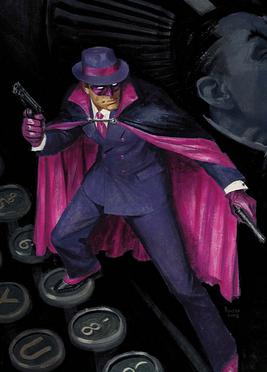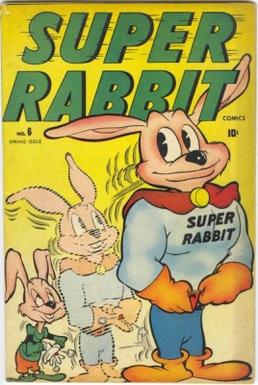
Timely Comics was the common name for the group of corporations that was the earliest comic book arm of American publisher Martin Goodman, and the entity that would evolve by the 1960s to become Marvel Comics.

Marvel Mystery Comics is an American comic book series published during the 1930s–1940s period known to fans and historians as the Golden Age of Comic Books. It was the first publication of Marvel Comics' predecessor, Timely Comics, a division of Timely Publications.

Black Widow is a character appearing in American comic books published by Marvel Comics. Created by writer George Kapitan and artist Harry Sahle, the character first appeared in Mystic Comics #4, published by Marvel predecessor Timely Comics. Claire Voyant is an anti-hero who kills evildoers to deliver their souls to her master, Satan.

The Angel is a superhero appearing in American comic books published by Marvel Comics. Created by artist Paul Gustavson and an unconfirmed writer during the Golden Age of Comic Books, the Angel first appeared in Marvel Comics #1, the first publication of Marvel Comics' predecessor, Timely Comics.

The All-Winners Squad is a fictional superhero team appearing in American comic books published by Marvel Comics. The company's first such team, it first appeared in All Winners Comics #19, published by Marvel predecessor Timely Comics during the period fans and historians call the Golden Age of Comic Books.
Alfred Dean Avison was an American comic book artist known for his work on the Marvel Comics characters the Whizzer, which he co-created, and Captain America during the 1930–1940s period known to fans and historians as the Golden Age of comic books.

Daredevil is a fictional superhero created by Jack Binder, who starred in comics from Lev Gleason Publications during the 1930s–1940s period that historians and fans call the Golden Age of comic books. The character was retroactively established into the Image Universe by Image Comics in the 1990s as its first character. The character is unrelated to Marvel Comics' Daredevil, and recent renditions of the character have often renamed him Doubledare or The Death-Defying Devil to avoid confusion and potential lawsuits.

Atlas Comics was the 1950s comic-book publishing label that evolved into Marvel Comics. Magazine and paperback novel publisher Martin Goodman, whose business strategy involved having a multitude of corporate entities, used Atlas as the umbrella name for his comic-book division during this time. Atlas evolved out of Goodman's 1940s comic-book division, Timely Comics, and was located on the 14th floor of the Empire State Building. This company is distinct from the 1970s comic-book company, also founded by Goodman, that is known as Atlas/Seaboard Comics.

The Blazing Skull is a fictional character appearing in American comic books published by Marvel Comics. The character was created during the Golden Age of Comic Books by Marvel's predecessor, Timely Comics, and first appeared in Mystic Comics #5. The character's writer and artist creators are unknown. The Blazing Skull fell into obscurity after the 1940s, and was revived in the 1990s.

The Blonde Phantom is a fictional masked crime fighter appearing in American comic books published by Marvel Comics. Created for Marvel predecessor Timely Comics by Stan Lee and Syd Shores, the character first appeared in All Select Comics #11, during the 1940s period fans and historians call the Golden Age of Comic Books. The heroine was so well received that the next issue was retitled The Blonde Phantom. The series continued to feature her until issue #22. She also appeared in backup stories in many other Timely comics; in Superhero Comics of the Golden Age, Mike Benton observes that "for a few months in 1948, readers could find her in seven titles on the newsstand." In The Supergirls, Mike Madrid asserted, "Once again, a capable woman hid behind a meek persona and only let her hair down, literally, to come to the aid of a man who completely ignored her unless she assumed a disguise. In a 1947 story entitled "I Hate Myself", Louise even dreams that Mark finally confesses his love for her, only to have the Blonde Phantom persona appear and steal him away."

Father Time is a fictional superhero appearing in American comic books published by Marvel Comics. The character was created by writer Stan Lee and artist Al Avison and first appeared in Captain America Comics #6, published by Marvel predecessor Timely Comics during the period fans and historians call the Golden Age of comic books. He was one of the many costumed operatives who were recruited into the United States military.

The Black Marvel is a fictional superhero appearing in American comic books published by Marvel Comics. Created by artist Al Gabriele with an unknown writer, he first appeared in Mystic Comics #5, published by Marvel's 1930s forerunner Timely Comics during the period fans and historians call the Golden Age of Comic Books.

Blue Diamond is a fictional superhero appearing in American comic books published by Marvel Comics, debuting under the company's 1940s forerunner, Timely Comics. The character was created in 1941 by Ben Thompson, who also drew the first comic book adventures of Ka-Zar the Great and Citizen V for Timely, as well as the Masked Marvel for Centaur Publications and Dr. Frost for Prize Comics.

Amazing-Man is a comic book superhero whose adventures were published by Centaur Publications during the 1930s to 1940s in the Golden Age of Comic Books. Historians credit his creation variously to writer-artist Bill Everett or to Everett together with Centaur art director Lloyd Jacquet. Amazing-Man first appeared in Amazing-Man Comics #5 —there were no issues numbered #1–4).

The Phantom Reporter is a fictional character appearing in American comic books published by Marvel Comics. He had no known superpowers until he inherited the powers of the hero known as Fiery Mask.

Rockman is a fictional superhero appearing in American comic books published by Marvel Comics. The character first appeared in U.S.A. Comics No. 1, published by Marvel predecessor Timely Comics during the 1930s to 1940s period historians and fans call the Golden Age of Comics. As credits were not routinely given in comic books of this period, his writer and artist co-creators are unknown, although the first page of his debut story was drawn by Charles Nicholas and the remainder by Basil Wolverton.

Super Rabbit is a talking animal superhero in american comic books published by Timely Comics, a predecessor of Marvel Comics, during the 1930s and 1940s period fans and historians call the Golden Age of comic books. Created by cartoonist Ernie Hart, he first appeared in Comedy Comics #14.

The Whizzer is a superhero appearing in American comic books published by Marvel Comics. He first appeared during the period called the Golden Age of Comic Books.
Mystic Comics is the name of three comic book series published by the company that eventually became Marvel Comics. The first two series were superhero anthologies published by Marvel's 1930-1940s predecessor, Timely Comics, during what fans and historians call the Golden Age of comic books. The third, simply titled Mystic, was a horror fiction-suspense anthology from Marvel's 1950s forerunner, Atlas Comics.

The Destroyer is the name of three fictional superheroes appearing in American comic books published by Marvel Comics. The original incarnation was created by writer Stan Lee and artist Jack Binder and first appeared in Mystic Comics #6, being one of Lee's earliest creations during the Golden Age of Comic Books.



















